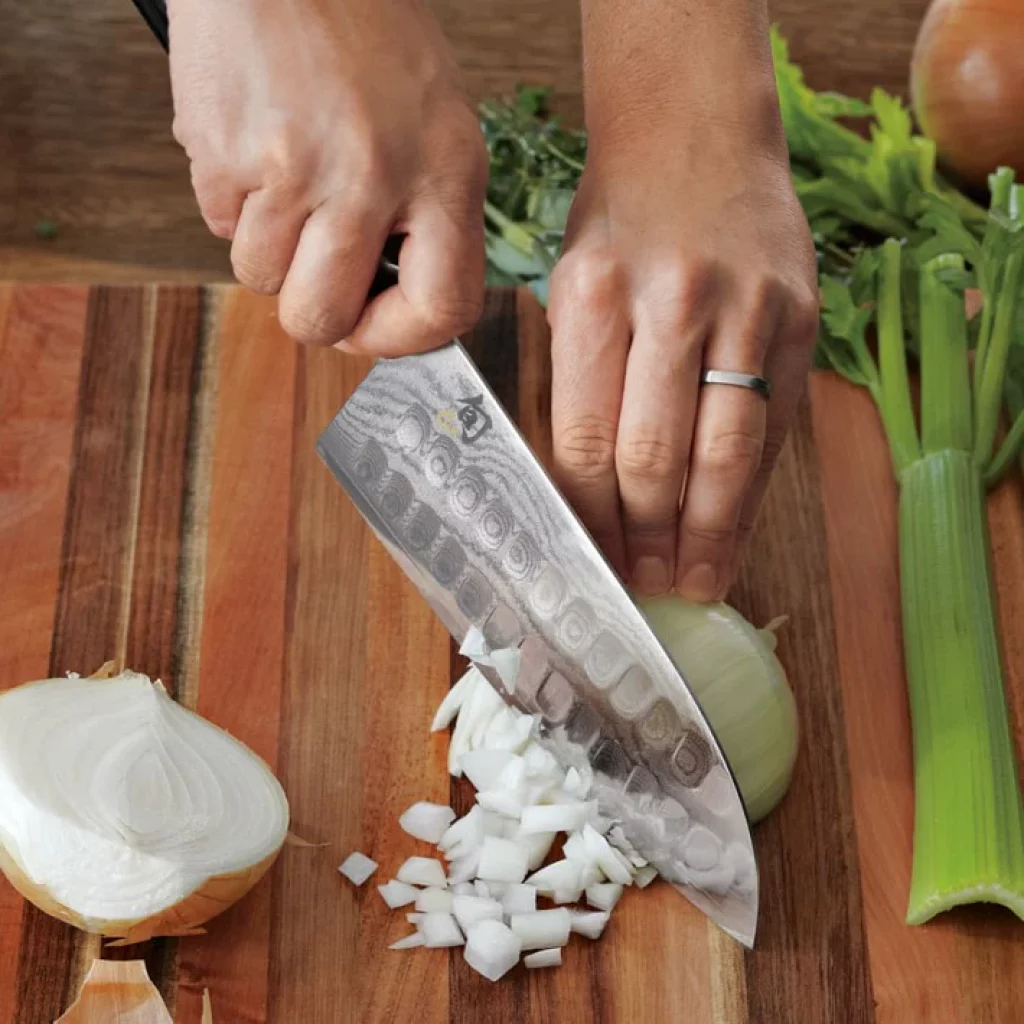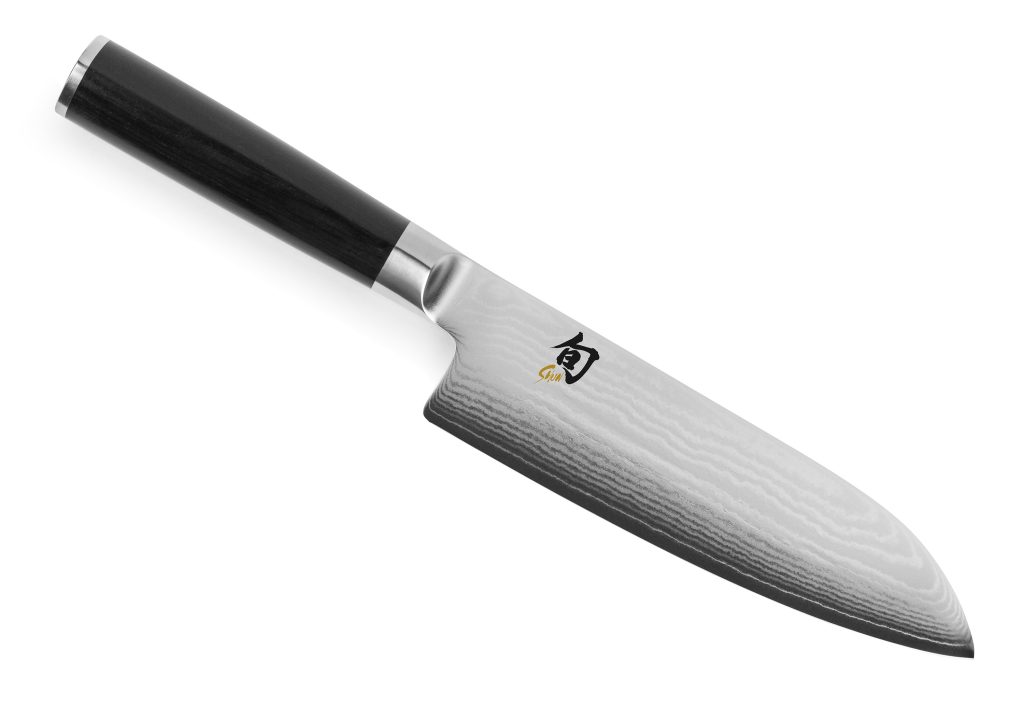Santoku knives (also called nakiri bocho) are a type of Japanese vegetable knife used for chopping hard vegetables. While it may look like a cleaver, its flat edge is very different from using and is much more precise than a cleaver. The best santoku knives have blades from high-carbon stainless steel that can hold an edge longer than carbon or non-stainless steel blades.

They also have handles made from wood or plastic, so they won’t rust when moisture is exposed while cutting vegetables in the sink or washing them under running water. Santoku knives are designed to cut through thick pieces of food with the flat side of the blade and do not have pointed tips as traditional vegetable knives do.
The Best Uses for Santoku Knives
Santoku knives are the best for cutting vegetables. They have a very thin blade, so you can use them for delicate tasks like dicing celery or julienning carrots. If you want to get fancy with your knife skills, you can use a santoku to make beautiful garnishes like rosemary flowers or artichoke hearts.
Santokus are excellent choppers! Their sharpness makes them perfect for chopping herbs into fine pieces for soups and sauces—you won’t have any problem mashing garlic cloves into a paste with this knife!
Vegetables
The Santoku knife is not just the best tool for most vegetables. It’s the only one you’ll need. It’s called a “santoku” because it makes chopping vegetables so easy that it allows you to focus on other things. A typical Western-style chef’s knife has a narrow blade with a pointed tip, making it good for precise cuts but less ideal for harder foods like root vegetables and winter squashes.
The Santoku is wide at its base and tapers toward the end—its shape ensures that all of your efforts go into slicing through whatever food you’re working on instead of being wasted on wedging into dense materials or slipping off hard surfaces.
Chopping herbs
You can use the flat edge of a Santoku knife to chop herbs. If you’re chopping herbs that are already bruised, this is a great way to ensure they don’t get more damaged by being chopped. To do it, place the flat side of your knife against your cutting board and press down hard enough to stick in place while you chop away with your other hand.
If you’re using fresh herbs, lay them on top of one another with their stems facing down to form an even pile when stacked together (this will give them more stability). Then grab hold of two leaves at once and cut them off at an angle from where they join together at their base—you want to make sure not just one but both layers are severed from each other, so there aren’t any pieces left behind when you’re done!
When doing this technique for something like parsley or cilantro leaves which tend towards bruising easily, you should ensure those ends get cut off before proceeding into recipe prep mode. Otherwise, those delicate little bits could easily get crushed underneath all those juicy bites we’ll take later tonight.
How to Use a Santoku Knife
- Hold the knife at a 45-degree angle.
- Place your thumb on the blade’s spine and lay your fingers on either side.
- If you’re left-handed, hold the handle in your left hand and change “thumb” and “index finger” to “index finger” and “middle finger.”
- You’ll use this grip to guide your hand while cutting food.
How to Hold a Santoku Knife Correctly
Hold the knife firmly in one hand, then press the blade into your palm until you feel a small indentation. This is known as “the dimple” and indicates that you are holding your knife correctly. Do not use a Santoku knife on meat or poultry!
Choose one hand over two.
Santoku knives are designed to be used with one hand. The length of the blade and its design allow the chef to grip it in one hand and use the other for support. While you can use two hands with a Santoku knife, it’s not recommended because it makes it difficult to control the blade. But suppose you’re chopping herbs on your cutting board, which often requires more delicate movements than slicing up raw chicken or vegetables. In that case, two hands are better since they can provide more stability as you cut through delicate leaves and stems.
Don’t use a Santoku knife on meat or poultry.
A santoku knife is not a meat cleaver or a chopping knife. It’s a utility blade for all kinds of kitchen work, but it was invented for vegetables, fruits and other soft foods—not poultry or meat.
When you use the wrong tool for the job (a Santoku knife on poultry), you have to put more pressure on your chopping technique so that the blade can cut through tough fibres like chicken skin or bone. This causes hand strain and fatigue in your upper body that can lead to injury over time if you keep using this style of the knife on harder foods like meats and bones.
Best Santoku Knife Brands
Shun Classic 7-Inch Santoku Knife By Koki Holdings America, LTD (Shun)

They are designed to be lightweight and easy to handle, which is important for those with arthritis or other hand disabilities. In addition to the scalloped edge, another feature that helps make this knife easy to use is its thinness. It has a blade thickness of 1/8 inch, which makes it lighter than most other knives with similar-sized blades. If you have problems gripping objects firmly, this can make all the difference in your ability to cut food without accidentally cutting yourself or dropping the knife on your foot!
A Shun Classic 7-Inch Santoku Knife By Koki Holdings America, LTD (Shun) has an ergonomic handle made from Japanese oak wood. It features an octagonal design that fits comfortably in your palm while providing excellent grip even when wet. In addition, the blade itself has been precision ground, so there are no jagged edges along its length, making it safe for you if you need extra help while holding onto something slippery like raw meat or fish fillets.
Masahiro MVH Santoku by Masahiro Co., Ltd. (Masahiro)
The Masahiro MVH Santoku by Masahiro Co., Ltd. (Masahiro) Japanese-style santoku knife with a single bevelled edge and a flat blade is a comfortable and versatile tool perfect for chopping vegetables or slicing meats.
The blade measures 6 inches long, making it ideal for handling most kitchen tasks. For example, the Santoku’s curved shape allows you to rock the knife back and forth when cutting foods like onions or garlic without exerting too much pressure on the tip of your fingers. You can also use this knife confidently while preparing meat because its flat blade helps you keep your knuckles off any raw surfaces while providing enough traction to keep your food from dropping as it gets sliced up into smaller pieces.
Wusthof Classic 7-Inch Santoku Knife by Wusthof Trident of America, Inc. (Wusthof)
As a santoku knife, the one you choose should be light and manoeuvrable. This Wusthof Classic 7-Inch Santoku Knife by Wusthof Trident of America, Inc. (Wusthof) has an ergonomic handle that’s comfortable in your hand and provides good control over the blade. The blade is made from high-carbon no, stained steel for easy sharpening and maintains its edge for longer than most other knives. If you’re looking for a versatile knife with classic styling and quality construction, you’ll likely find what you need here.
Mercer Culinary Renaissance 6 1/2-Inch Forged Santoku by Mercer Tool Corp. (Mercer Culinary)
The Mercer Culinary Renaissance 6 1/2-Inch Forged Santoku by Mercer Tool Corp. (Mercer Culinary) is a knife that’s been around for nearly 50 years and has stood the test. It’s made in the U.S., forged from high-carbon stainless steel, and has a lifetime warranty against manufacturing defects. This knife is less than half the price of most high-end Santokus today!
Conclusion
Many great options exist if you’re looking for the best santoku knife. Of course, the best one for you will depend on your budget, but we hope our guide and reviews help you find the perfect one!






